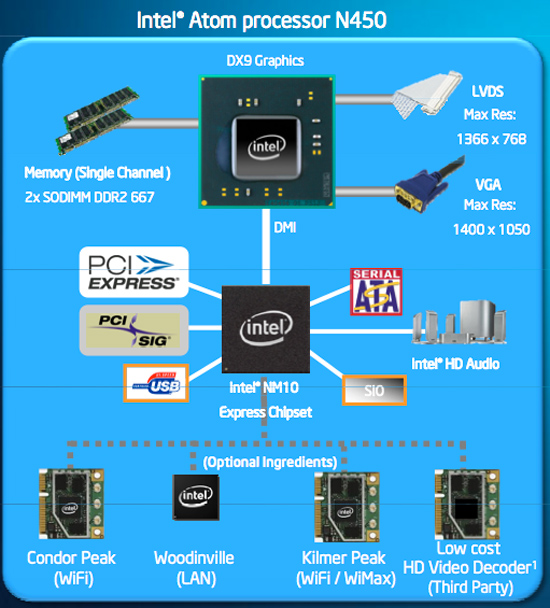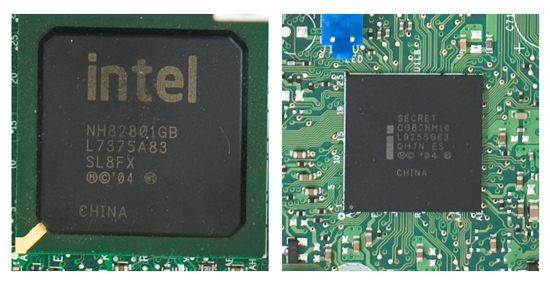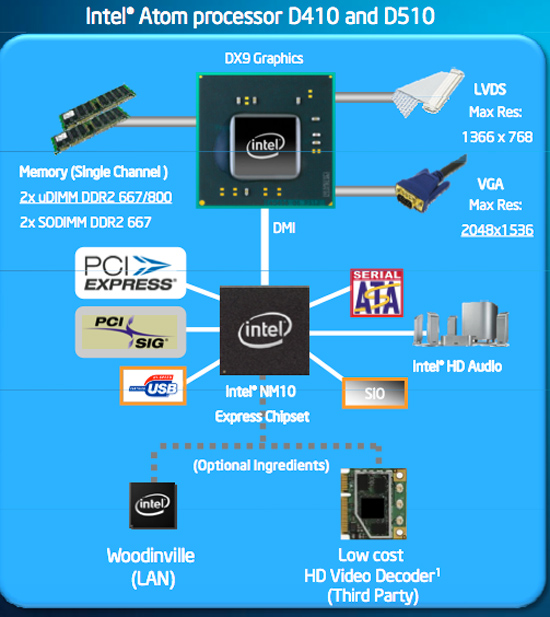Intel Atom D510: Pine Trail Boosts Performance, Cuts Power
by Anand Lal Shimpi on December 21, 2009 12:01 AM EST- Posted in
- CPUs
No Native Hardware H.264 Decoding: Long Live Ion
The integrated GMA 3150 graphics hasn’t been used by Intel before, it’s a 45nm shrink of the GMA 3100. It’s technically a DX9 GPU running at 400MHz, however as you’ll soon see - you can’t really play any games on this platform. The GPU only offers hardware acceleration for MPEG-2 video, H.264 and VC-1 aren’t accelerated.

Max output resolution is also limited. The best you can get over a digital connection (HDMI/DVI) is 1366 x 768, over analog VGA you can do 2048 x 1536 (only 1400 x 1050 on the N450). It’s a curious coincidence, Poulsbo also had a 1366 x 768 digital output limitation.

Dual-core Atom "Pineview", the left half are the two CPU cores, the right portion is GPU + memory interface
And now we see why Intel skimped on the GPU abilities: nearly half the die is used for graphics.

Single-core Atom "Pineview"
On the single core part, more than half the die is the GPU/memory controller. At 32nm this won’t be a problem, but today at 45nm it is what it is - we get a mediocre GPU.
The NM10 Express Chipset
Pine Trail is all about integration. Pulling the memory controller and GPU on-die let board makers either build smaller, simpler or more feature rich motherboards. In fact, one of the benefits of integration is that all Atom motherboards can now be built using 4 layer PCBs. Previously, only the desktop Atom boards could be built on 4 layer PCBs, now netbook boards can be just as cost effective.

The old ICH7 (left) vs. the new NM10 (right) - pictures are to scale, the NM10 is really that much smaller
With the memory controller and GPU on-die, the “chipset” in Pine Trail has been reduced to a single chip external to the CPU. It’s called the NM10 Express Chipset and it connects to the new Atom CPU via a 2.5GB/s DMI link.
Intel’s NM10 supports 8 USB 2.0 ports, two SATA ports, HD audio, 2 x 32-bit PCI slots and 4 PCIe lanes. The NM10 is derived from existing ICH technologies, but bundled in a smaller package for use in small form factor motherboards.
Intel lists one interesting “optional ingredient” that can be connected to the NM10 chipset: a third party HD video decoder.

The FTC hasn’t won it’s case yet so most manufacturers still prefer to support Intel and would rather pair Pine Trail with a Broadcom H.264 decoder than go for something like Ion. It’s Intel’s concession to those who demand high definition video acceleration. Honestly, I would’ve preferred to see something that could do it natively instead of relying on a 3rd party solution. I suspect that the 3rd generation of Atom will solve this; at 32nm there’s more than enough transistor budget to integrate a GMA4500 series core, which would finally bring Atom up to feature parity with NVIDIA’s Ion chipset...just two years later
What About Ion 2?
Pine Trail uses Intel’s DMI to connect Pineview and the NM10 chipset. NVIDIA doesn’t have Intel’s blessing to sell chipsets that use DMI, so NVIDIA can’t produce something that takes the place of the NM10 chip.
NM10, however, has an integrated PCIe controller. It’s possible that NVIDIA’s next-generation Ion will simply connect via PCIe to the NM10 chip.










41 Comments
View All Comments
Jeffk464 - Monday, December 21, 2009 - link
This might be a decent solution with the broadcom media chip making it capable of playing HD content and hopefully flash media.dealcorn - Monday, December 21, 2009 - link
If I am reading correctly the Intel platform with Broadcom media accelerator (about $25) is cheaper than the Ion platform and will consume less energy. Some relevant perfortmance testing may help determine whether the Intel platform is positioned to dominate the frugal HTPC market.It is a bummer that you will need to spend chump change for a SATA port card to enable software raid 5 for a frugal media server.
Likely, the incremental performance improvements are adequate for Intel to maintain its cachet in the dissed, real world netbook market with its surprisingly large volumes.
Its kinda a nothing platform, but in context may be a home run.
Jeffk464 - Monday, December 21, 2009 - link
For it to be a solution for me it needs to be on a mobo that has a pcie slot and hdmi through the broadcom chip. I'm not to hopeful though, will probably end up with a i3 solution. Too bad, I like the idea of going super low wattage.psychobriggsy - Monday, December 21, 2009 - link
The platform is standing still apart from getting more integrated. Hopefully that will mean cheaper. Maybe some netbooks will get cheaper, but otherwise the platform is a complete waste of time because of the lack of HD video capability (for Intel to call the graphics "HD Graphics" is verging on consumer misrepresentation, it can't even do 1080p output via HDMI/DVI, what is this, 2005?).Why did the review concentrate on benchmarks of applications nobody would run on such a system?
These chips are a solution for nothing apart from the unwealthy Office user who needs 8 hours of battery instead of 6.
Jeffk464 - Monday, December 21, 2009 - link
It can be used for a low power/cost network storage device.Zool - Monday, December 21, 2009 - link
There could be a test with underclocked and undervolted E5300 against the Atom D510. Maybe Power vs performance would be quite close if not better for the E5300. I think that everyone could take another 10W for a performance thats not crapy (even netbooks).Calin - Monday, December 21, 2009 - link
10 more watts would mean going from 8-9 hours of socket-free operation down to 6 (or maybe less). Not acceptable for the people that want 8 hours of socket-free operation. As for higher performance CPU, you have the low voltage processors (CULV), which will better fit the bill.Zool - Monday, December 21, 2009 - link
Thing is that 10+ more wats in CPU doesnt mean that u use it all the time. For internet browsing and so (not like u can use it efectivly for something more) the cpu isnt working 100% all the time just sporadicly.Majority of the power usage in those scenarios is in the rest of the hardware like display ,gpu, mainboard which runs all the time.
And i dont even say that with faster cpu the task are faster done so u use the cpu on 100% state less time in total.
Atom is the only one of its kind now and without competition it will stay this crapy for long time.
cjs150 - Monday, December 21, 2009 - link
There are 3 markets for this type of product: notebooks, HTPC and cheap file servers:HTPC market: complete failure because the graphics are not up to scratch
Cheap file server: only SATA ports but I could add my raid card to this but the given the cost it would be cheaper to buy a NAS box
Notebooks: barely adequate - word processing and simple internet browsing only.
So for 2 out of 3 markets it is a waste of space and the 3rd market it is merely sub-par what is already out there
Jeffk464 - Monday, December 21, 2009 - link
Don't give up yet, mobo manufacturers have the option to put a broadcom media chip on their boards. I don't know if this will come with HDMI though. Have to wait and see.